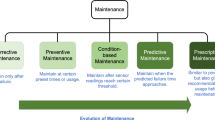Abstract
Monitoring and collision avoidance systems are a standardized part in nowadays machine tools. The configuration and parameterisation of these systems require expert knowledge about the process and the machine tool. Using the monitoring system in different process types and with varying tools makes it necessary to adapt and change the parameterisation. Considering the acceleration and friction influences, these perturbations are independent from the process itself. This paper describes a solution method which identifies these perturbations, monitors the characteristics during the process and adapts the correction model if required. Then the possibilities for monitoring operation based only on digital drive signals will be explained.








Similar content being viewed by others
References
Dimla DE (2000) Sensor signals for tool-wear monitoring in metal cutting operation: A review of methods. Int J Mach Tools Manuf (40):1073–1098
Klocke F, Reuber M, Klocke F, Reuber M (2000) Sicheres Freiformfräsen mit on-line-Prozessüberwachung: on-line process monitoring in sculptured milling. wt Werkstattstechnik online 90(4):119–122
Dimla DE, Lister PM (2000) On-line metal cutting tool condition monitoring: I: force and vibration analyses. Int J Mach Tools Manuf 40:739–768
Lou K-N, Lin C-J (1996) An intelligent sensor fusion system for tool monitoring on a Machining Center. pp 208–214
Konrad H, Isermann R, Heintz N (1995) Model based fault detection in milling by classification of estimated cutting parameters. In: IEEE international conference on systems, man and cybernetics. Intelligent systems for the 21st Century, vol 3, pp. 2193–2198
Konrad H (1996) Fault detection in milling using parameter estimation and classification methods. Control Eng Pract 4(11):1573–1578
Klocke F, Reuber M, Kratz H (2000) Application of a wavelet-based signal analysis for evaluating the tool state in cutting operations. In: 26th annual conference of the IEEE Industrial Electronics Society, 22–28 October 2000, Nagoya, Aichi, Japan, vol 3, pp. 1967–1972. doi:10.1109/IECON.2000.972577
Shi D, Axinte D, Gindy N (2006) Online machining process monitoring using wavelet transformation and SPC. pp 2081–2086
Franco-Gasca LA, Herrera-Ruiz G, Peniche-Vera R, Remero-Troncoso J, Leal-Tafolla W (2006) Sensorless tool failure monitoring system for drilling machines. Int J Mach Tools Manuf 46:381–386
Kaever M, Weck M (1997) Intelligent process monitoring for rough milling operations based on drive currents and machine integrated sensors. In: Wiens HG (ed) Manufacturing science and engineering, vol 1. Dallas, pp. 97–104
Kaever M, Brouer N, Rehse M, Weck M (1997) NC integrated process monitoring and control for intelligent autonomouse manufacturing systems. pp 69–74
Kaever M (2005) Steuerungsintegrierte Fertigungsprozeßüberwachung bei spanender Bearbeitung, Diss. Norderstedt: Books on Demand
Weck M, Plapper V (2001) Sensorless machine tool condition monitoring based on Open NCs. In: IEEE Power Engineering Society, international conference on robotics and automation, 21–26 May 2001, Coex Seoul, Korea
Plapper V (2003) Steuerungsintegrierte Zustands-überwachung von Vorschubantrieben an Werkzeugmaschinen”, Diss., RWTH
Adam W, Pritschow G, Uhlmann E, Weck M, Adam W (eds) Zukunftsweisende Anwendungen integrierter Sensorsysteme. Düsseldorf: VDI-Verl., 1999///2000
Xiaoli L (2005) Development of current sensor for cutting force measurement in turning. IEEE Trans Instrum Meas 54(1)
Payandeh S, Adams J (1996) On methods for low velocity friction Compensation: theory and experimental study, in Journal of Robotic Systems, pp 391–404
Olsson H, Astrom KJ, Cabudas de Wit C, Gäfert M, Lischinsky P (2007) Friction models and friction compensation. Available at http://www.lag.ensieg.inpg.fr/canudas/publications/friction/dynamic_friction_EJC_98.pdf
Konrad H (1997) Modellbasierte Methoden zur sensorarmen Fehlerdiagnose beim Fräsen, Diss. Düsseldorf: VDI-Verl
Hänsler E (1997) Statistische Signale: Grundlagen und Anwendungen, 2nd edn. Springer, Berlin
Maragos P, Kaiser JF, Quatieri TF, Maragos P, Kaiser JF, Quatieri TF (1993) Energy separation in signal modulations with application to speech analysis. IEEE Trans Signal Process 41(10): 3024–3051
Kaiser JF (1990) On a simple algorithm to calculate the “energy” of a signal. IEEE, New Jersey
Li X, Du R, Denkena B, Imiela J, Li X, Du R, Denkena B, Imiela J (2005) Tool breakage monitoring using motor current signals for machine tools with linear motors”. IEEE Trans Ind Electron 52(5):1403–1408. Available at doi:10.1109/TIE.2005.855656
Acknowledgments
The research project IP 011815 NEXT Generation Production Systems is funded under the 6th Framework Program. The Laboratory for Machine Tools and Production Engineering gratefully acknowledges this support.
Author information
Authors and Affiliations
Corresponding author
Rights and permissions
About this article
Cite this article
Brecher, C., Rudolf, T. Adaptive logging module for monitoring applications using control internal digital drive signals. Prod. Eng. Res. Devel. 3, 305–312 (2009). https://doi.org/10.1007/s11740-009-0160-6
Received:
Accepted:
Published:
Issue Date:
DOI: https://doi.org/10.1007/s11740-009-0160-6




